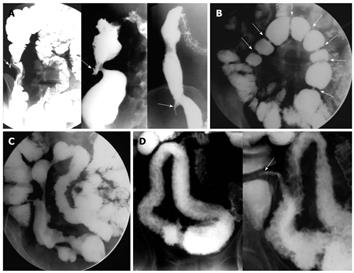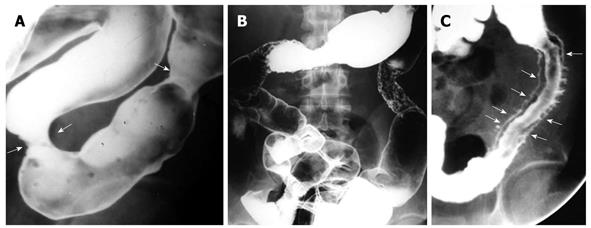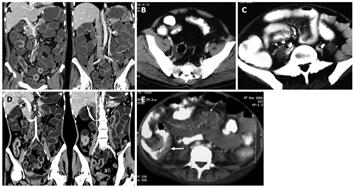Copyright
©2011 Baishideng Publishing Group Co.
World J Gastroenterol. Jan 28, 2011; 17(4): 433-443
Published online Jan 28, 2011. doi: 10.3748/wjg.v17.i4.433
Published online Jan 28, 2011. doi: 10.3748/wjg.v17.i4.433
Figure 1 Findings on barium study of the small intestine.
A: Barium study in three different patients with tuberculosis (TB) demonstrating shrunken, conical and retracted cecum (arrows); B: Multiple strictures (arrows) in ileal loops of a patient with TB. Note the short, concentric and smooth outline of the strictures; C: Multiple eccentric strictures seen in the ileum of a patient with Crohn's disease (CD). Note the normal ileo-cecal junction; D: Barium study showing an ulceronodular pattern involving a long segment of the ileum in a patient with CD. Note sparing of the ileo-cecal junction (arrow).
Figure 2 Findings on barium study of the colon in tuberculosis and Crohn's disease.
A: Barium enema showing tubercular strictures (arrows) of the colon; B: Barium enema demonstrating skip lesions affecting descending and transverse colon as ulcers with areas of narrowing in a patient with Crohn's disease (CD); C: Deep ulcers with double tracking of sigmoid colon in a patient with CD (arrows).
Figure 3 Findings on computed tomography.
A: Computed tomography (CT) enteroclysis with negative oral contrast showing mural thickening of ileum with skip areas and sparing of cecum in a patient with Crohn's disease (CD); B: Contrast-enhanced CT scan (CECT) showing asymmetrical mural thickening in ileal loop with deep ulcerations. Note fibro-fatty proliferation of mesentery; C: CECT in another patient with CD showing mesenteric vascular engorgement (Comb sign) with fibro-fatty proliferation of the mesentery; D: CT enteroclysis with negative oral contrast showing contiguous mural thickening of the terminal ileum and cecum in a patient with tuberculosis (TB); E: CECT in a patient with TB showing mural thickening of the terminal ileum and cecum (thick arrow) with multiple enlarged mesenteric lymph nodes showing central hypoattenuating and peripherally enhancing rims (thin arrow).
Figure 4 Histological features.
A: Confluent granulomas in inflammatory granulation tissue from ulcerated colonic mucosa of a patient with tuberculosis (TB) [Hematoxylin and eosin (HE), 100 ×]; B: Large granuloma in the ulcerated mucosa of a patient with TB (HE, 100 ×); C: Microgranuloma composed of a small aggregate of macrophages in a lymphoid follicle from the mucosa of a patient with Crohn's disease (CD) (HE, 400 ×); D: Small pericryptal granuloma in the colonic mucosa of a patient with CD (HE, 100 ×).
- Citation: Pulimood AB, Amarapurkar DN, Ghoshal U, Phillip M, Pai CG, Reddy DN, Nagi B, Ramakrishna BS. Differentiation of Crohn’s disease from intestinal tuberculosis in India in 2010. World J Gastroenterol 2011; 17(4): 433-443
- URL: https://www.wjgnet.com/1007-9327/full/v17/i4/433.htm
- DOI: https://dx.doi.org/10.3748/wjg.v17.i4.433












